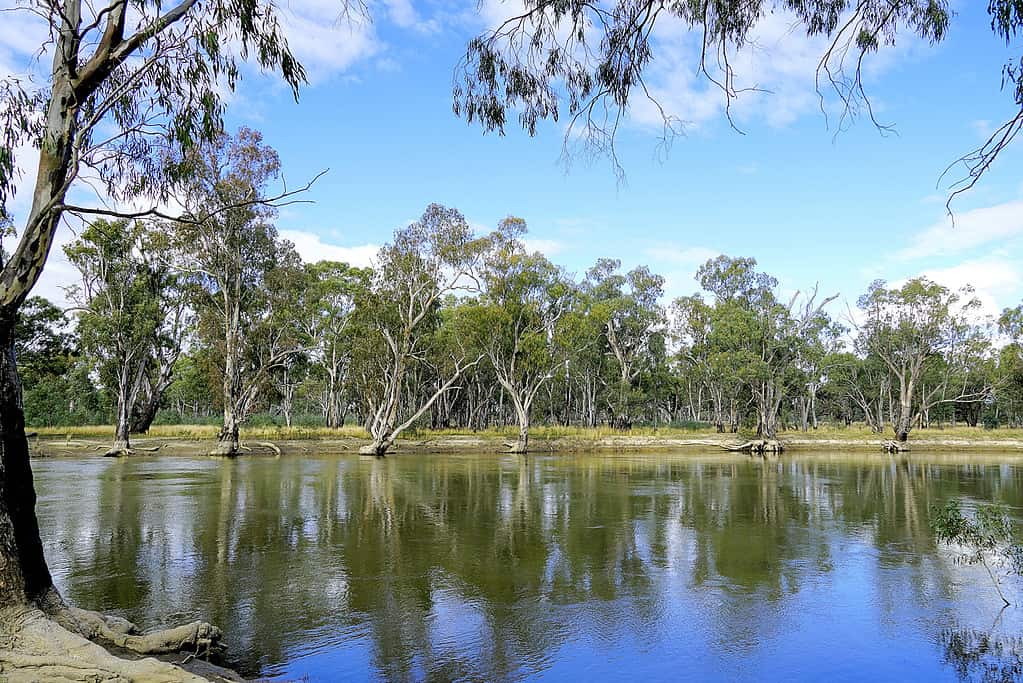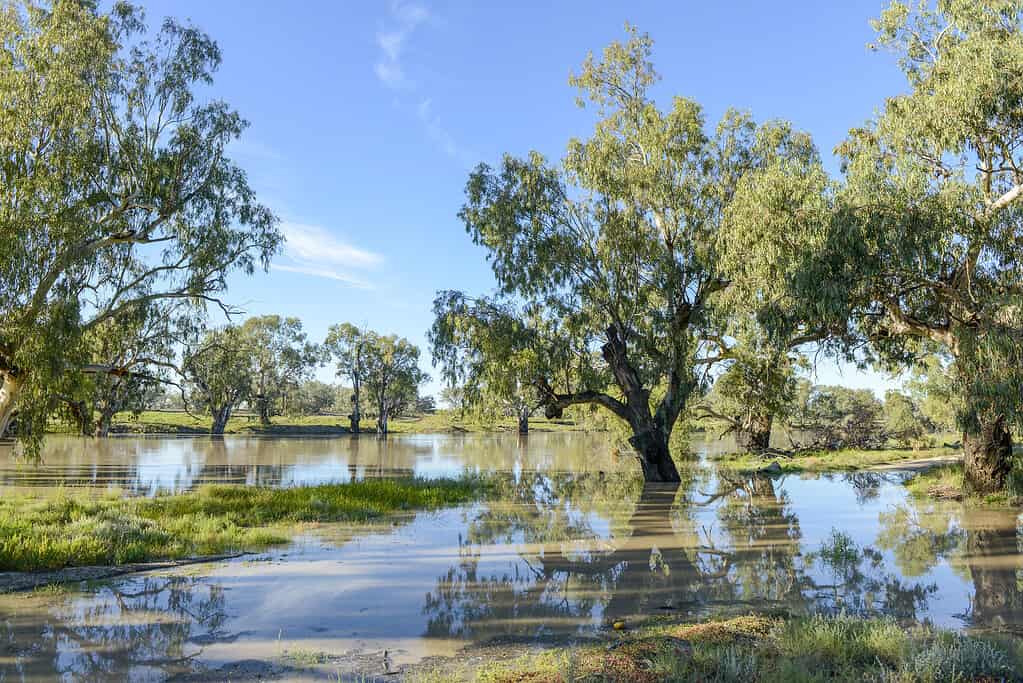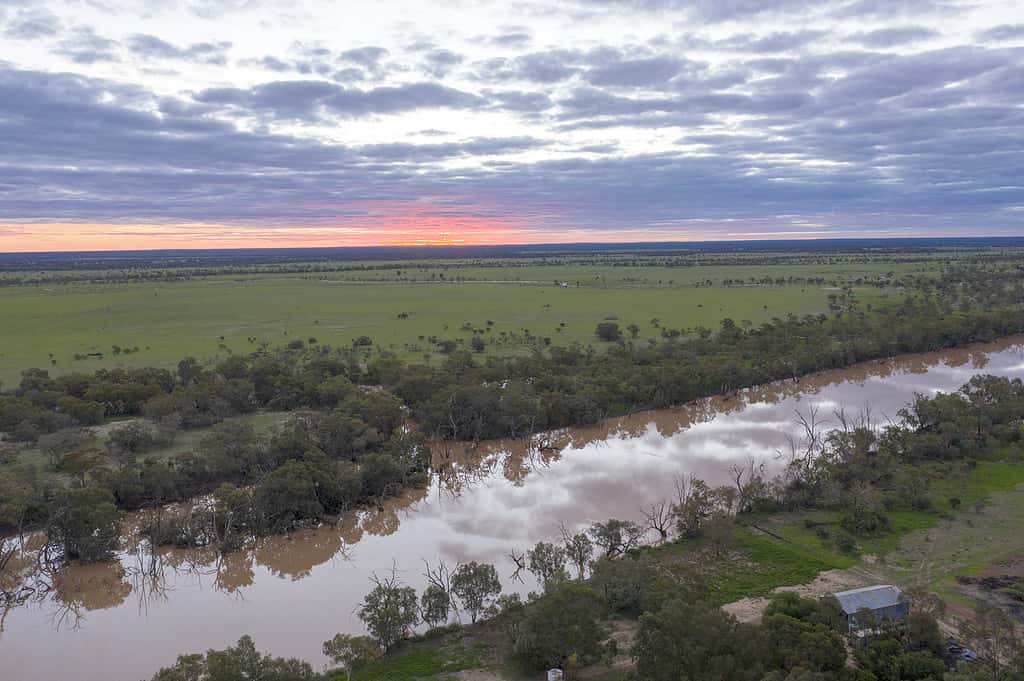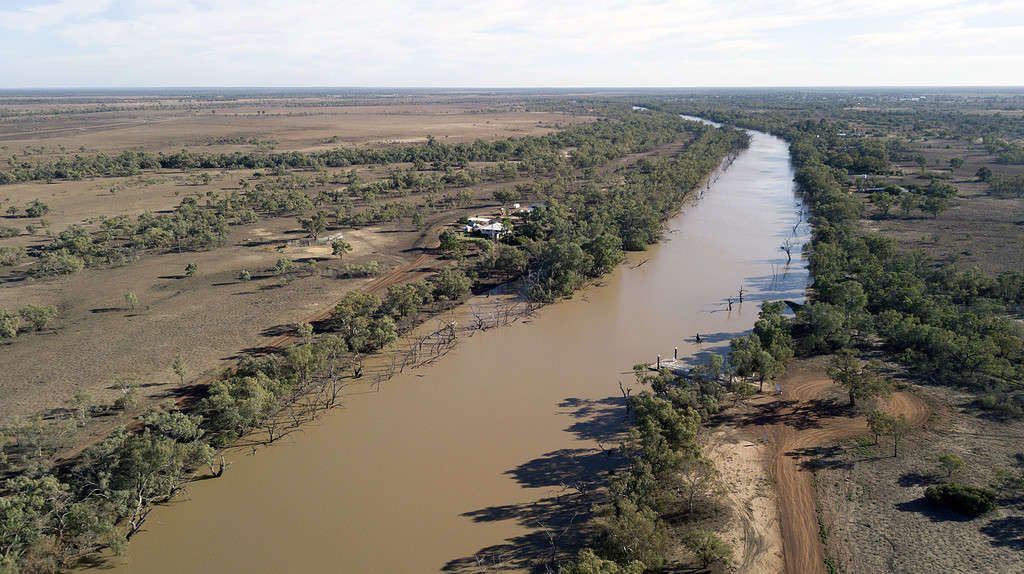Australia is home to some of the most venomous creatures in the world. In fact, Australia ranks third for having the most venomous animals. Still, Australia has some of the most potent venomous animals within its borders.
Many of these venomous creatures reside in the wild rivers coursing throughout the country. Anyone interested in visiting Australia and traversing its hundreds of rivers should be aware of the unique and venomous snakes lurking in the water.
This article will guide you on the many rivers of Australia, the venomous snakes that inhabit them, and how to recognize them to avoid bites.

The Murray River is the longest river in Australia.
©fotofritz16/iStock via Getty Images
Basics on Australia
Australia has approximately 439 rivers coursing throughout the country. Many of these rivers flow out to the Pacific Ocean surrounding the country, while others flow inland toward Lake Eyre.
Across the country’s 2.968 million square miles, resides 140 different types of land snakes, and 32 types of sea snakes. Among these snakes, 100 are venomous, but only 12 are potent enough to kill humans.
Only the 12 potent venomous snakes count toward the total number of venomous creatures in the world ranking because they pose a threat to humans. Without a quick injection of anti-venom, a snake bite from any one of these 12 snakes could kill a human within minutes.
7 Major Rivers in Australia
There are 439 rivers stretching across Australia. Many of these rivers turn into small streams or connect to larger rivers. Australia has seven major rivers that are connected to the Murray-Darling River Basin.
The Murray-Darling River basin starts in the Australian Alps, draining West from New South Wales and Victoria to South Australia. The river basin stretches 3375 kilometers (2097 miles) long.
Venomous snakes inhabiting one river can be found in the others because they are all connected by the Murray River
The Murray River
Murray River is the longest in Australia. It stretches 2375 kilometers or 1476 miles long. Worldwide, it is the 3rd longest river in the world next to the Amazon River being second at 6400 kilometers or 3977 miles long, and the Nile River first at 6650 kilometers or 4132 miles long.
The river is a major source of freshwater for nearly 1.5 million homes and farms across the country.

The Murray River starts in New South Wales and ends in South Australia.
©BenGoode/iStock via Getty Images
Snakes residing in the Murray River are:
| Northern Death Adder | Stoke’s Sea Snake | Green Tree Snake |
| Northern Dwarf Crowned Snake | Coastal Taipan | Freshwater Snake |
| Eastern Brown Snake | Red-Bellied Black Snake | Spotted Python |
| Yellow-faced Whipsnake | Brown Tree Snake | Carpet Python |
| Tiger snake | Northeastern Blind Snake | Amethystine Python |
The Murrumbidgee River
The Murrumbidgee River is the second longest river, branching out of the Murray River. Starting at Peppercorn Hill along the Long Plain region, it stretches 1485 kilometers or 923 miles and connects to the Murray River in New South Wales.
In the Aboriginal language of Wiradjuri, the word Murrumbidgee translates to “big water.” The river irrigates farmland to help produce 50% of the country’s river, 25% of New South Wales’ fruit and vegetables, and 90% of New South Wales’ potatoes.

Murrumbidgee River travels through the town of Riverina near Carrathool.
©barmah john/iStock via Getty Images
Snakes residing in the Murrumbidgee River:
| Broad-headed snake | Stoke’s Sea Snake | King Brown Snake |
| Little whip snake | Coastal Taipan | Freshwater Snake |
| Eastern-Small Eyed Snake | Red-Bellied Black Snake | Spotted Python |
| Yellow-faced Whipsnake | Brown Tree Snake | Carpet Python |
| Stephen’s Banded Snake | White-lipped Snake | Diamond Python |
| Colletts Snake | Eastern Brown Tree Snake | Lowland Copperhead |
| Stimsons Python | Tiger Snake | Common Death Adder |
The Darling River
The Darling River is the third longest river in Australia connecting to the Murray River. It starts between the towns of Brewarrina and Bourke and stretches 1472 kilometers or 915 miles.
Fishways or “fish ladders” were constructed in the river to allow fish to move through the river in low-water zones where they can be stranded. Locals inform visitors that the fish can climb ladders to continue their trek downriver.

The Darling River is known to flood during the rainy seasons. The flooded river is sustained well enough that nearby crops can thrive.
©JohnCarnemolla/iStock via Getty Images
Snakes residing in the Darling River:
| Broad-headed snake | Stoke’s Sea Snake | King Brown Snake |
| Little whip snake | Coastal Taipan | Freshwater Snake |
| Eastern-Small Eyed Snake | Red-Bellied Black Snake | Spotted Python |
| Yellow-faced Whipsnake | Brown Tree Snake | Carpet Python |
| Stephen’s Banded Snake | White-lipped Snake | Diamond Python |
| Colletts Snake | Eastern Brown Tree Snake | Lowland Copperhead |
| Stimsons Python | Tiger Snake | Common Death Adder |
| Brown Tree Python | Green Tree Python | Inland Taipan |
The Lachlan River
The Lachlan River is the next longest river, flowing 1448 kilometers or 900 miles long. It starts in the Breadalbane Plans near Goulburn and flows west to Riverine and the Great Cumbungi Swamp.
The Lachlan River was vital in the development of New South Wales by regulating water to the surrounding towns and irrigating farms for wheat fields and sheep pastures. There is a dam in Cowra which forms the Wyangala Reservoir.

The Lachlan River connects to several smaller rivers and a lake, filling their depths for wildlife to flourish.
©barmah john/iStock via Getty Images
Snakes residing in the Lachlan River:
| Red-bellied Black Snake | Tiger Snake | Carpet Python |
| Eastern Brown Snake | Diamond Python | Highland Copperhead |
The Warrego River
The Warrego River is 1380 kilometers or 808 miles long and is the fifth river making up the Murray-Darling River Basin. It starts at Mount Kaka Mundi, at the start of the Darling River, and flows from Queensland to Cunnamulla in New South Wales.
The Australian Aboriginal language of Bidyara translated Warrego as “river of sand.” This is because the river dries up and does not flow during droughts in the dry seasons of May to October.

The Warrego River risks drying up during droughts, making it difficult to farm or capitalize for irrigation.
©JohnCarnemolla/iStock via Getty Images
Snakes residing in the Warrego River are:
| Broad-headed snake | Stoke’s Sea Snake | King Brown Snake |
| Little whip snake | Tiger Snake | Common Death Adder |
| Eastern-Small Eyed Snake | Red-Bellied Black Snake | Spotted Python |
| Yellow-faced Whipsnake | Brown Tree Snake | Carpet Python |
| Stephen’s Banded Snake | White-lipped Snake | Diamond Python |
Cooper Creek
Cooper Creek stretches from Queensland to South Australia. This is a total of 1300 kilometers or 808 miles. Cooper Creek is connected to the Murray-Darling River Basin and part of the Great Dividing Range that pours into Lake Eyre.
The river is seen as unreliable because it experiences unpredictable rainfall. Unpredictable and unreliable rainfall makes growing crops near the river problematic. However, it provides fresh water for cattle and sheep in nearby towns.

Due to unpredictable rainfall, Cooper Creek can either have low water levels or heavily flood like in the photo seen here.
©JohnCarnemolla/iStock via Getty Images
Snakes residing in Cooper Creek are:
| Broad-headed snake | Stoke’s Sea Snake | King Brown Snake |
| Little whip snake | Tiger Snake | Common Death Adder |
| Eastern-Small Eyed Snake | Red-Bellied Black Snake | Spotted Python |
| Yellow-faced Whipsnake | Brown Tree Snake | Carpet Python |
| Stephen’s Banded Snake | White-lipped Snake | Diamond Python |
The Paroo River
The Paroo River is the last of the seven major rivers in Australia, extending from Queensland to South Australia. In total, the river is 1210 kilometers or 753 miles long.
The Paroo River is home to dozens of species like snakes, birds, amphibians, and small mammals. The wetlands are nationally protected to preserve the conservation of these animals

The Paroo River is the 7th longest river in Australia, ending with the Murrary-Darling River in Queensland.
©JohnCarnemolla/iStock via Getty Images
Snakes residing in the Paroo River are:
| Broad-headed snake | Stoke’s Sea Snake | King Brown Snake |
| Little whip snake | Tiger Snake | Common Death Adder |
| Eastern-Small Eyed Snake | Red-Bellied Black Snake | Spotted Python |
| Yellow-faced Whipsnake | White-lipped Snake | Carpet Python |
Ways to Avoid Snakes in Australia’s Rivers
Information is always the best tool to keep yourself safe from wildlife, especially with venomous animals like snakes.
- Identify The Snake: Learning to identify the different types of snakes is the most important advice and information when going near wildlife. Recognizing the type of snake will dictate how venomous that specific snake is, how to proceed when encountering it, and the type of anti-venom needed in case there is a bite.
- Stay Calm: Being afraid and trying to attack the snake will increase the chance of a bite. Snakes naturally want to avoid conflict with larger predators because it is a waste of their energy. Venomous snakes will warn a predator first and attempt to flee rather than fight. Snakes are at a disadvantage in the water, increasing the chances of them approaching a boat.
- Remain Vigilant: Australian waters are filled with dangerous creatures. Predators like crocodiles or insects can be circling without warning. While these predators will avoid humans, accidental strikes may happen. The best practice is to stay in the boat and follow signs that warn against swimming.
The photo featured at the top of this post is © Benny Marly/Shutterstock.com
Thank you for reading! Have some feedback for us? Contact the AZ Animals editorial team.







